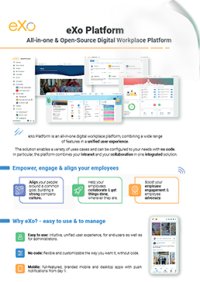

FREE DATASHEET
Download the eXo Platform Datasheet and discover all the features and benefits
Prior to social collaboration tools, knowledge-dependent firms, such as consulting firms and investment banks, encouraged group-wide emails when someone asked or answered a question related to their work. That’s because they found that the same questions were being asked over and over when the answer only went to one person.
By copying the entire group on these emails, everyone could learn from the answer. While this was an improvement, the information didn’t necessarily arrive when anyone needed it, it wasn’t easy to search for at a later date, and it wasn’t available to employees who were hired after it was sent.

Furthermore, when experts left the company, all of their valuable knowledge left with them. One of the most important assets companies have is the knowhow and expertise that employees accumulate over years. Capturing this elusive “silent knowledge” has been a painful problem for many organizations who don’t want to lose critical insights and need to reinvent the wheel each time an employee leaves.
Fast-forward to today, and social collaboration tools achieve the same benefits of those group-wide emails. Only now, this question would get a response from a knowledgeable network of experts that would become instant and searchable content, available to all at any future date through a search function. That means you can find the answer when you need it, even if you didn’t work at the company when the question was originally asked. It also means the information will still be available if the person who answered the question leaves the company.
With social tools, capturing elusive human expertise becomes a lot easier – a far cry from having to constantly update a database for example. Instead of having to make knowledge capturing an extra task, it happens automatically because discussions are being recorded as they happen. From knowledge capturing and management perspective this process where knowledge almost effortlessly gets turned into content is a big step forward.
This can drastically reduce the time and costs it takes to train new, or promoted, employees. Rather than a lengthy onboarding process where the trainee would sit through classroom training and speak with multiple colleagues to get ramped up, they can simply learn the basics upfront and dig into the use-case specific information when they need it. The quicker ramp-up and on-demand access to important information allows employees to become productive quicker, thus reducing the cost of training.
Xerox implemented this type of training system in the 1980s. They initially trained their tech reps in classrooms and provided manuals for troubleshooting, but found that reps learned best by reaching out to their peers when they needed help. Xerox enabled this type of knowledge sharing with two-way radios, but realized the shortcomings because the conversations weren’t being recorded. Once they started using a social network to capture the knowledge reps were sharing with one another, they were able to save over $100 million per year on training costs.

eXo Platform : The Open-Source
Digital Workplace Platform
Download the eXo Platform Datasheet and discover all the features and benefits


Download the eXo Platform Datasheet and discover all the features and benefits
You will find here Frequently Asked Questions about Knwoledge Management Software (KMS) with all the answers in one place.
Knowledge Management Software (KMS) is a technology solution that helps organizations capture, organize, share, and make the most of their collective knowledge. It acts like a corporate brain—a centralized hub where employees can access company policies, project documentation, best practices, technical specifications, FAQs, and other critical information.
➝ See the full definition of Knowledge Management Software (KMS).
Knowledge Management Software (KMS) comes in many forms, each tailored to different needs, audiences, and organizational goals. No single tool fits every use case—some focus on customer-facing knowledge, others on internal collaboration or AI-powered discovery.
Below is a guide to the main types of Knowledge Management Software and what makes each one unique.
➝ Find out the different types of Knowledge Management Software.
Knowledge Management Software (KMS) is more than just a digital repository—it’s your organization’s searchable brain. It centralizes policies, how-to guides, troubleshooting steps, customer answers, R&D notes, and “tribal knowledge” (the know-how that lives in employees’ heads) all in one place. A robust KM system transforms scattered information into actionable knowledge, helping teams work smarter, faster, and more collaboratively.
Here’s why Knowledge Management Software matters:
Knowledge Management Software (KMS) delivers measurable, organization-wide impact. Beyond simply storing information, a well-implemented KMS improves productivity, speeds up problem-solving, preserves expertise, and fosters a more connected and innovative workplace.
Let’s explore the key benefits and outcomes businesses can expect when adopting a robust knowledge management strategy.
➝ Find out the Key Benefits of Knowledge Management Software.
Knowledge is one of the most valuable assets of any organization. But in today’s fast-paced, hybrid work environments, simply having information isn’t enough. Teams need the right Knowledge Management (KM) software to capture, organize, share, and retrieve knowledge efficiently. The right tool can boost productivity, improve onboarding, accelerate problem-solving, and even enhance customer experience. Choosing it, however, requires more than comparing features—it’s about matching the software to your team’s workflow, culture, and long-term goals.
This guide will help you evaluate Knowledge Management tools effectively, provide a detailed feature checklist, and offer practical recommendations to ensure adoption and impact.
➝ Find out the best way How to Choose the Right Knowledge Management Software.
( Your e-mail address will not be published)
I am the Chief Executive Officer of eXo Platform (the open source digital workplace platform), a company that I co-founded while in college and that I came back to after several years in the banking and consulting industry. I blog about modern work, about open-source and sovereignty issues. Occasionally, I also blog about my personal areas of interest, such as personal development, work–life balance, sustainability and gender equality.